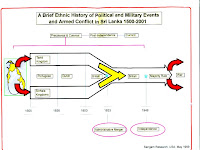A Brief Colonial History Of Ceylon(SriLanka)
Sri Lanka: One Island Two Nations
A Brief Colonial History Of Ceylon(SriLanka)
Sri Lanka: One Island Two Nations
(Full Story)
Search This Blog
Back to 500BC.
==========================
Thiranjala Weerasinghe sj.- One Island Two Nations
?????????????????????????????????????????????????Thursday, March 2, 2017
New Antibiotics Urgently Needed to Combat Resistant Bacteria
Credit: WHO/Jim Holmes
ROME/GENEVA, Feb 28 2017 (IPS) -
The United Nations health organisation has just published its first
ever list of antibiotic-resistant “priority pathogens” – a catalogue of
12 families of bacteria that pose the greatest threat to human health.
The list was drawn up in a bid to guide and promote research and development (R&D) of new antibiotics, as part of the World Health Organization (WHO) efforts to address growing global resistance to antimicrobial medicines.
The list highlights in particular the threat of gram-negative bacteria
that are resistant to multiple antibiotics. These bacteria have built-in
abilities to find new ways to resist treatment and can pass along
genetic material that allows other bacteria to become drug-resistant as
well, WHO reported on Feb. 27.
“This list is a new tool to ensure R&D responds to urgent public
health needs,” says Dr Marie-Paule Kieny, WHO’s Assistant
Director-General for Health Systems and Innovation. “Antibiotic
resistance is growing, and we are fast running out of treatment options.
If we leave it to market forces alone, the new antibiotics we most
urgently need are not going to be developed in time.”
New resistance mechanisms are emerging and spreading globally,
threatening our ability to treat common infectious diseases, resulting
in prolonged illness, disability, and death.
Without effective antimicrobials for prevention and treatment of
infections, medical procedures such as organ transplantation, cancer
chemotherapy, diabetes management and major surgery (for example,
caesarean sections or hip replacements) become very high risk.
Three Categories According to Urgency of Need
Three Categories According to Urgency of Need
The WHO list is divided into three categories according to the urgency
of need for new antibiotics: critical, high and medium priority.
• Antibiotic resistance is one of the biggest threats to global health, food security, and development today.
• Antibiotic resistance can affect anyone, of any age, in any country.
• Antibiotic resistance occurs naturally, but misuse of antibiotics in humans and animals is accelerating the process.
• A growing number of infections – such as pneumonia, tuberculosis, and gonorrhoea – are becoming harder to treat as the antibiotics used to treat them become less effective.
• Antibiotic resistance leads to longer hospital stays, higher medical costs and increased mortality.
The most critical group of all includes multidrug resistant bacteria
that pose a particular threat in hospitals, nursing homes, and among
patients whose care requires devices such as ventilators and blood
catheters.
They include Acinetobacter, Pseudomonas and various Enterobacteriaceae (including Klebsiella, E. coli, Serratia, and Proteus). They can cause severe and often deadly infections such as bloodstream infections and pneumonia.
These bacteria have become resistant to a large number of antibiotics,
including carbapenems and third generation cephalosporins – the best
available antibiotics for treating multi-drug resistant bacteria.
The second and third tiers in the list – the high and medium priority
categories – contain other increasingly drug-resistant bacteria that
cause more common diseases such as gonorrhoea and food poisoning caused
by salmonella.
Tuberculosis – whose resistance to traditional treatment has been
growing in recent years – was not included in the list because it is
targeted by other, dedicated programmes, says the UN specialised body.
“Other bacteria that were not included, such as streptococcus A and B
and chlamydia, have low levels of resistance to existing treatments and
do not currently pose a significant public health threat.”
WHO explained that the criteria for selecting pathogens on the list
were: how deadly the infections they cause are; whether their treatment
requires long hospital stays; how frequently they are resistant to
existing antibiotics when people in communities catch them; how easily
they spread between animals, from animals to humans, and from person to
person; whether they can be prevented (e.g. through good hygiene and
vaccination); how many treatment options remain; and whether new
antibiotics to treat them are already in the R&D pipeline.
“New antibiotics targeting this priority list of pathogens will help to
reduce deaths due to resistant infections around the world,” warned Prof
Evelina Tacconelli, Head of the Division of Infectious Diseases at the
University of Tübingen and a major contributor to the development of the
list.
“Waiting any longer will cause further public health problems and dramatically impact on patient care.”
